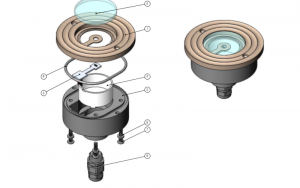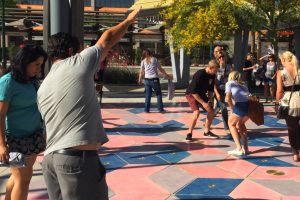Mesa Musical Shadows – Montréal’s venerable Daily tous les jours studio
For this assignment, I chose the work Mesa Musical Shadows because it both serves as an interactive art project and also a media that actually produces real music. It allows the audience to engage in spontaneous exploration, play, and even compose their own music. The piece was created for th
e Mesa Arts Centre, Arizona, known to be the sunniest state. This piece is created by Montréal’s venerable Daily tous les jours studio. It is installed in the north plaza at the Mesa Arts Center in Arizona. Mesa Musical Shadoes have four modes which will change according to the four different time periods (Morning, midday, evening and night) of the day. This is controlled by a MaxMSP patch linking Arduino Mega boards via OSC. Most sounds here were composed by sound designer David Drury to reflect varying atmospheres and — pragmatically — shadow lengths throughout the day. The installation’s 47 sensors are run through six control nodes, comprised of an Arduino Mega, ethernet shields, and custom connector shields – each of which is protected in a waterproof enclosure, placed underneath the tiling. Each sensor unit has a custom PCB with a light sensor on top and an LED on its bottom. The music is coded to the sensors, for nighttime illumination and the more sensitive gear (computers, amplifiers, etc.) is all installed in the museum.


A normal sensor will be easy to create for anyone who owns some coding skill, however, what Mesa Musical Shadows is manifested by creator’s artistic sensibilities of audiences’ relationship with the artwork. Quoted from “Creative Application Networks”, “From simple post-it notes to fully interactive mats, we brought different prototypes on site to get direct feedback and help refine the project … These consultations helped us figure out what the project’s essence had to be and hopefully, the results honor that process and reflect the community’s various contributions.”

![[OLD FALL 2017] 15-104 • Introduction to Computing for Creative Practice](../../../../wp-content/uploads/2020/08/stop-banner.png)